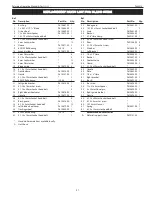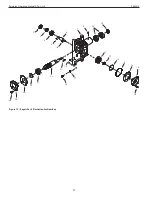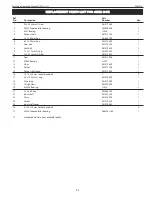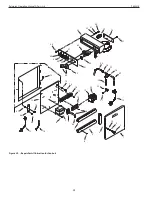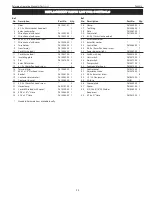
TROUBLESHOOTING (CONTINUED)
12
Palmgren Operating Manual & Parts List 9683314
Motor stalls (resulting in blown fuses
or tripped circuit breakers)
Frequent opening of fuses or
circuit breakers
Motor problems in general
Teeth ripping from blade
Motor running too hot
Coolant does not flow
Excessive blade breakage
Premature blade dulling
1. Short circuit in motor; connections loose; or
shorted terminals or worn insulation on lead
wires
2. Low voltage
3. Incorrect fuses or circuit breakers
4. Motor overloaded
1. Motor overloaded
2. Incorrect fuses or circuit breakers
Various causes
1. Teeth too coarse for work
2. Too heavy feed
3. Too slow speed
4. Vibrating workpiece
5. Gullets loaded
1. Blade tension too high
2. Blade too coarse for work (pipes especially)
3. Blade too fine for work (heavier, soft material)
4. Gears need lubrication
1. Pump motor burned out
2. Dirty screen/filter on pump
3. Loose impeller
4. Coolant level too low
1. Material loose in vise
2. Incorrect speed or feed
3. Teeth too coarse for material
4. Incorrect blade tension
5. Teeth in contact with work before
saw is started
6. Blade rubs on wheel flange
7. Misaligned guides
8. Blade too thick for wheel diameter
1. Teeth too coarse
2. Too much speed
3. Inadequate feed pressure
4. Hard spots or scale in/on material
5. Work hardening of material (especially
stainless steel)
6. Blade installed backwards
7. Insufficient blade tension
1. Inspect terminals in motor for damaged
insulation and shorted wires
2. Correct the low line voltage conditions
3. Install correct fuses or circuit breakers
4. Reduce load on motor
1. Reduce load on motor
2. Install correct fuses or circuit breakers
To troubleshoot and service motor consult
qualified technician
1. Use finer tooth blade
2. Decrease feed pressure
3. Increase speed
4. Clamp work securely
5. Use coarse tooth blade or use brush to
remove chips
1. Reduce tension on blade
2. Use finer tooth blade
3. Use coarser blade
4. Check oil bath
1. Replace pump
2. Clean
3. Tighten
4. Refill coolant tank
1. Clamp work securely
2. Check Machinist Handbook
3. Check Machinist Handbook for
recommended blade type
4. Adjust to where blade does not slip on wheel
5. Place blade in contact with work after motor
is started
6. Adjust tracking
7. Adjust guide bearings
8. Use thinner blade
1. Use finer tooth blade
2. Try next lower speed
3. Decrease spring pressure
4. Reduce speed, increase feed of saw
5. Increase feed pressure by reducing spring
tension
6. Remove blade, twist inside out and reinstall
blade
7. Increase tension to proper level
SYMPTOM
POSSIBLE CAUSES
CORRECTIVE ACTION





















